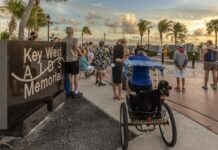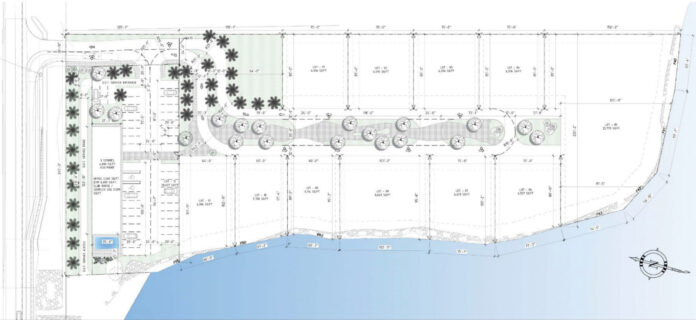A preliminary site plan for an upcoming development, division of land for other existing homes and an amendment to Marathon’s comprehensive plan to allow for a runway move at the Marathon airport all drew scrutiny before their eventual recommendations for approval at the Jan. 23 Marathon Planning Commission meeting.
The commission first considered a conditional use permit and site plan by Vaca Homes LLC – owned by developer Guillermo Torres – for the currently cleared land on Vaca Cut’s southeast edge next to San Pablo Catholic Church. As submitted, the site plan includes 11 residential homes and a clubhouse with a gym, meeting room and office space.
Commissioners Mike Cinque, Mary Ann Royse and Andrew George spearheaded a lengthy discussion of traffic considerations when entering or exiting the development. With no break in the median immediately in front of the proposed homes on U.S. 1, those approaching the development from the east or wishing to proceed west from the turnoff would need to make U-turns on U.S. 1 or use the parking lots of existing businesses near the Vaca Cut bridge.
Torres has received approval from the Florida Department of Transportation (FDOT) for the creation of a deceleration lane for cars approaching the site from the west, and is working toward approval for an acceleration lane as cars exit the development traveling east before merging onto the busy highway. He said a new left-turn lane on the westbound side of U.S. 1, as suggested by several commissioners, was already denied by FDOT.
He additionally stated his intent to make some of the gym and clubhouse facilities close to U.S. 1 accessible to the public, though commission chair Matt Sexton pointed out that the commission would not have a chance to vote in the future on Torres’ changes to the development’s commercial space.
In a 3-2 vote, with Cinque and Sexton as “no” votes, the commission recommended approval of the development, adding as conditions that Torres should continue his pursuit of FDOT approval for the acceleration lane and that the city should install “No U-Turn” signs at the highway median break near the intersection of 117th Street and U.S. 1.
Torres and city staff also fielded a laundry list of questions from George over the creation of divided lots for Torres’ existing La Palma development. Situated between 101st and 104th streets on the oceanside, the project has been scrutinized in recent years as what was previously deemed non-buildable land with protected native vegetation was eventually developed with three single-family homes along with three deed-restricted affordable duplexes.
The development again earned the local spotlight when the Marathon City Council voted 4-1 in November 2022 to use six administrative relief building allocations to allow completion of the duplexes – the homes’ original building allocations were revoked in August 2022, along with nearly 300 others in Marathon.
Previously listed as a single parcel, the new division creates three lots for the single-family homes, six lots for the existing duplexes, one parcel of conservation land to be donated to the city, and one remaining vacant lot to be tied to potential commercial space along U.S. 1 to the north of the nine homes.
With city approval, a small walkway could traverse the existing mangrove area from the southernmost single-family home to the waterfront, as long as there is a 5-foot vegetative buffer between the walkway and residences to the east of the development.
The commission again voted 3-2 to recommend the proposed division, with Sexton and George as the “no” votes.
A final ordinance sought to amend Marathon’s comprehensive plan to mirror language used by Monroe County as it prepares for updates to the Marathon airport. In an effort to increase Marathon’s viability for commercial air traffic, the airport runway will eventually be moved roughly 40 feet to the northwest to comply with current FAA regulations. As a result, about 40 feet of the vegetative buffer on the airport’s north edge bordering Aviation Boulevard will be removed to create a new Runway Object-Free Area (ROFA).

Though the airport is located within Marathon’s city limits, Florida’s Airport Law of 1945 gives Monroe County regulatory authority over the site, rendering the runway move possible regardless of Marathon’s decision to change its comprehensive plan language.
Cinque expressed concern with a city board “rubber-stamping” removal of the vegetative buffer, while commissioner Mark Senmartin and Sexton opined that aligning with the county’s goals could at least give Marathon a voice to request items like a sound barrier wall or other noise reduction efforts.
Adopting the proposed change would also allow a request that vegetation removed would be replanted with native species in a mitigation effort in a 3:1 ratio, not the county’s 2:1 ratio. The proposed ordinance also requires removal of all invasive exotic vegetation in the development area.
Planning director Brian Shea confirmed that the altered comprehensive plan language would have no impact on developments outside the airport.
“They’re going to do this no matter what we say here tonight,” said Senmartin. “The only thing we can do is add in a little piece, ‘Could you, while you’re doing this?’ I think it doesn’t hurt.”
The council voted 4-1 to recommend approval of the ordinance, with Cinque as the lone “no” vote.



















